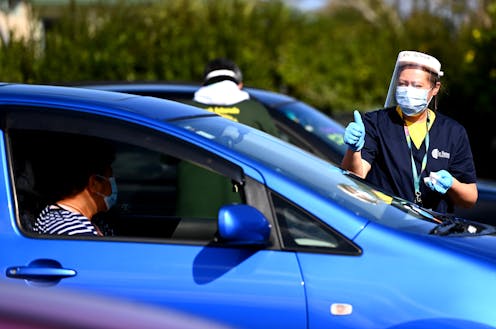The COVID-zero strategy may be past its use-by date, but New Zealand still has a vaccination advantage
- Written by Michael Plank, Professor in Applied Mathematics, University of Canterbury

The announcement today that New Zealand will introduce a vaccination certificate by November is welcome news. Whether by “carrot” or “stick”, vaccination rates must keep climbing, as it is now likely case numbers will climb under alert level 3 conditions in Auckland.
We’ve seen a growing number of mystery cases over the past couple of weeks – people testing positive after going to hospital for non-COVID reasons, or from essential worker surveillance testing.
These cases suggest there is a significant amount of undetected community transmission, and that makes it much harder to stamp out.
While the slight easing of restrictions announced yesterday may or may not accelerate the growth in cases, it is unlikely to slow it. This has led to some debate about whether the government has abandoned its elimination strategy in favour of suppression of cases.
To some extent this is a semantic argument. Elimination has been defined as “zero tolerance” for community transmission, as opposed to zero cases. The fact that New Zealand was able to get to zero cases for much of the past 18 months has inevitably come to define what elimination has meant in practice.
Before vaccines were widely available, having zero cases was crucial in allowing us to enjoy level 1 freedoms. But New Zealand is now transitioning into a new phase of the pandemic, and this was always going to happen. Borders can’t remain closed forever and the virus was always going to arrive sooner or later.
Return to tougher restrictions still a possibility
In an ideal world, our border defences would have kept Delta out and New Zealand would have been able to stay at alert level 1 until the vaccine rollout was complete. But the Delta outbreak has forced our hand to some extent.
Whether another week or two at level 4 would have been enough to eliminate this outbreak is impossible to know. Given the outbreak is spreading in very difficult-to-reach communities, stamping out every chain of transmission is extremely challenging.
As we shift from an elimination to a suppression strategy, the country will have to tread a very narrow path to avoid overwhelming our hospitals and throwing our at-risk populations under the bus.
This includes Māori and Pasifika, who were effectively put at the back of the vaccine queue by dint of their younger populations, despite being at higher risk of severe COVID-19.
We are now relying on a combination of restrictions and immunity through vaccination to prevent cases growing too rapidly. As vaccination rates increase, restrictions can be progressively eased.
But if we relax too much, there is a risk the number of hospitalisations could start to spiral out of control. When the R number is above 1, cases will continue to grow relentlessly until either more immunity or tougher restrictions bring it back under 1.
Getting vaccination rates up is crucial but will take time, so the government may yet be forced to tighten restrictions to protect our healthcare systems.
The vaccination advantage
New Zealand was always going to have to grapple with these really tough decisions, though Delta has forced us to do this earlier than we would have liked.
But our elimination strategy has given us has an important advantage – almost 70% of the total population has had at least one dose of the vaccine before experiencing any large-scale community transmission.
We still have a lot of work ahead, but having access to the vaccine before being exposed to the virus is a luxury people in most countries didn’t have.
There is a lot that could happen between now and Christmas. Currently, the Australian state of Victoria has over 100 people in intensive care, which is equivalent to almost a third of New Zealand’s total ICU capacity. Those ICU beds are normally full with patients with conditions other than COVID-19.
The implications for the healthcare system are obvious. If New Zealand goes the way of Melbourne, harsher restrictions will probably be inevitable.
Not a white flag
The more optimistic scenario is that a combination of restrictions, vaccination and contact tracing is just enough to keep a lid on the case numbers. It’s almost inevitable cases will increase. But if it isn’t too rapid and hospitals can meet the demand, it could tide us over until we have the high vaccine coverage we need.
And while vaccination rates are not yet high enough, they are still helping a lot, cutting the R number to around half what it would be with no vaccine. The country is in a far better position now than it would have been if the Auckland outbreak had happened in May or June.
Everyone can do their bit by doing two things: help and encourage those around you to get vaccinated, and stick to the rules.
We have to keep community transmission rates low to keep pressure off our hospitals and help us get to the next step of the road map. Moving away from a literal interpretation of elimination does not mean waving a white flag.
Authors: Michael Plank, Professor in Applied Mathematics, University of Canterbury





